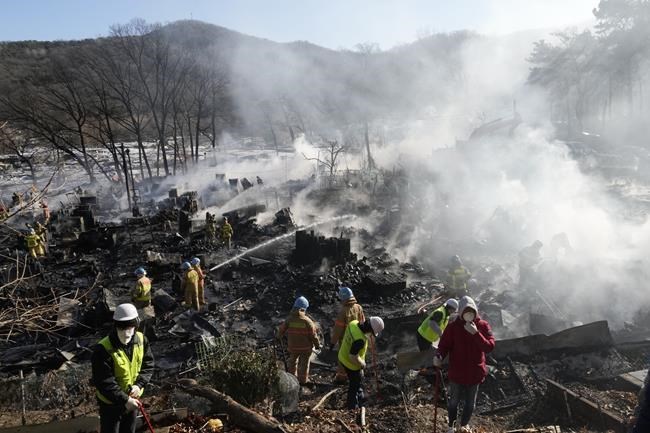SEOUL, South Korea (AP) — A fire early Friday destroyed at least 60 homes in a neighborhood of densely packed, makeshift housing surrounded by some of the wealthiest streets of South Korea’s ultra-modern capital, forcing about 500 residents to flee.
Firefighters extinguished the flames in Seoul’s Guryong village within about five hours, and officials said no injuries or deaths had been reported as of Friday afternoon.
Shin Yong-ho, an official at the fire department of Seoul’s Gangnam district, said rescue workers were continuing to search areas affected by the fire but that it was believed that all residents have safely evacuated.
More than 800 firefighters, police officers and public workers fought the flames and handled evacuations after the fire began around 6:30 a.m.
Photos showed firefighters fighting the flames under thick, white smoke covering the village as helicopters sprayed water from above. Later orange-suited rescuers searched through the charred landscape where gray tendrils of smoke were still rising. The capital's skyscrapers gleamed a short distance away.
Kim Ah-reum, an official at the Gangnam district office, said around 500 residents evacuated to nearby facilities including a school gym. Officials were planning to move an unspecified number of people whose homes were destroyed or severely damaged to three hotels.
“How could this happen on the Lunar New Year holidays,?" 66-year-old village resident Kim Sung-han told The Associated Press, referring to one of the country's biggest annual holidays that starts on the weekend and continues through Tuesday.
“I had to run out of home only in these clothes,” without being able to bring out anything else, Kim said. “I couldn't go to work ... when it's already so hard to live.”
Lee Woon-cheol, one of the community leaders at the village, said residents were able to swiftly share the news about the fire through their emergency contacts and that firefighters were going door-to-door searching for people and helping them evacuate.
“This is where a lot of accidents happen because of electrical short circuits,” Lee told the YTN news channel. "
Shin said it was presumed that the fire began at one of the village’s homes made with plastic sheets and plywood. He said the cause of the fire was being investigated.
The news of the fire alarmed South Korean President Yoon Suk Yeol, who while visiting Switzerland for the Davos meetings instructed officials to mobilize all available resources to minimize damage and casualties, his spokesperson Kim Eun-hye said.
The country is still reeling from its worst disaster in almost a decade, after nearly 160 people died in a crowd surge at a Seoul nightlife district in October. Experts blame that deadly crush on poor planning by police and administrative officials, who failed to employ basic crowd control measures despite anticipating huge gatherings of Halloween revelers.
Guryong village, an illegal encampment located near some of Seoul’s most expensive real estate marked by towering high-rise apartments and lavish shopping districts, has long been a symbol of South Korea's stark income inequalities.
The hillside village has often been damaged by fire over the years, a vulnerability that has been linked to its tightly packed homes built with materials that easily burn. Eleven houses were destroyed during a previous fire at the village in March last year, and around 100 people were forced to evacuate after parts of the area became flooded by rain last August.
The village, currently home to around 600 people, was formed in the 1980s as a settlement for people who were evicted from their original neighborhoods under the city’s massive house clearings and redevelopment projects.
Hundreds of thousands of people were removed from their homes in slums and low-income settlements during those years, a process the country’s then-military leaders saw as crucial in beautifying the city for foreign visitors ahead of the 1988 Seoul Olympic Games.
Seoul's city government first announced plans to redevelop the area in 2011 but the efforts have stalled over disagreements between city officials and residents over land compensation and other issues. __
AP video journalists Yong Ho Kim and Yong jun Chang contributed to the report.
Kim Tong-hyung, The Associated Press



